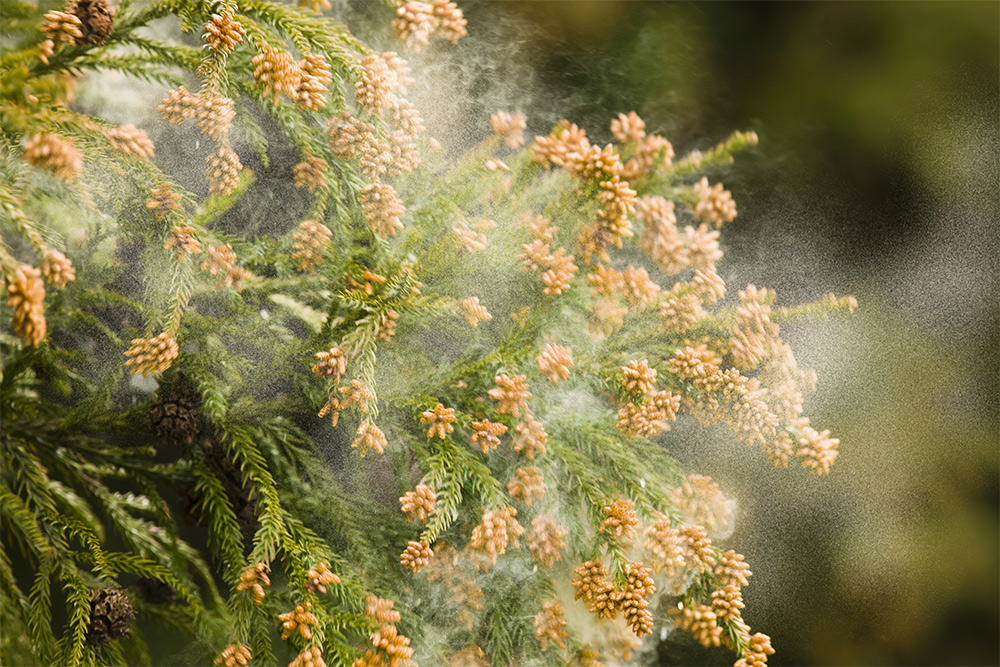From the end of winter to the beginning of spring, “hay fever” is very prevalent in Japan. “Hay fever” is an allergic disease caused mainly by pollen from plants such as cedar, cypress, ragweed, pine, grass, and yomogi(one of mugwort). It peaks from February to April, when pollen from these plants is in full swing. It has become a kind of “national disease” for Japanese people. The symptoms include sneezing, runny nose, stuffy nose, itchy eyes, etc. Now, it is said that about 1/4 of Japanese people have this “hay fever”… Therefore, during this time of the year, you can see that many people wear masks to protect themselves from colds and flu, as well as to protect themselves from pollen. Today, Wearing a mask is now a common practice to prevent the spread of COVID-19, which is still rampant in many parts of the world, isn’t it? Even before the COVID-19 pandemic, Japanese people were not very resistant to wearing masks at this time of the year. It is said to have prevented the spread of Covid-19 to some extent. Umm… To be honest, we have a little complicated feeling about that…
Well, well. Probably, this disease called “hay fever” has been around for a long time, but it was not until around the 1960s that “hay fever” became commonly known in Japan. After World War II, there was an urgent need to secure large amounts of lumber for the reconstruction of domestic industries. For building materials for houses. For woodworking products. To prevent flood damage, etc. So, large-scale afforestation / forestry was carried out all over Japan. For this purpose, cedar and cypress were used because of their high growth rate. Until about the 1970s, a lot of these domestic woods were used. However, logging and thinning have stagnated due to the importation of overseas timber at low prices and a decrease in demand for wooden houses. As a result, very large areas of cedar and cypress forests were left behind. There are only a few virgin forests in the mountains of Japan today. Most of cedar and cypress forests in Japan have been created by plantation / forestation. Well, it’s probably a disease that has existed for a long time. However, due to the accumulation of various factors, it has come to afflict so many people that it is now called a “national disease”. There is no doubt that it is a “modern disease… Of course, the degree / frequency of symptoms varies from person to person, but symptoms such as sneezing, runny nose, stuffy nose, itchy eyes, etc. usually last from late January to mid-May. In addition, some plants that are the cause of the disease have their peak pollen dispersal in autumn, which means that the disease occurs at every seasonal change. It’s almost like there’s no time for it to stop all year round… It’s a real problem. This is why there are so many anti-“hay fever” devices and medicines on the market in Japan. Glasses, goggles, and masks. Hats and clothings to prevent pollen from sticking. Air conditioners and air purifiers to remove pollen that enters (or has entered) the room. Blowers and humidifiers / dehumidifiers that are recommended to be used in conjunction with these. Various medications to control hay fever symptoms. Foods and recipes to boost immunity to allergy symptoms. There are many books that explain and introduce the above mentioned ones. There are so many products related to “hay fever”. Every time the seasons change, we feel as if forced to think about “hay fever”.
It seems that hay fever is not an irrelevant disease for those who come to Japan from overseas or stay/reside in Japan for a long time. It is not unusual for the disease to come on suddenly. You never know what will trigger it. Oh. Of course, it seems that hay fever exists in many parts of the world, right? The people who actually suffer from “hay fever” have a really hard time with it, we have heard that. Even if they don’t have to worry about infecting others like a cold or flu, symptoms such as sneezing or a stuffy nose can cause a lot of worry and discomfort to others. This can cause a lot of trouble. Especially last year/this year, many people are more sensitive to the COVID-19 infection, so it is even more hard for them. So, everyone. We should actively try to take care of each other, really. Whether you have “hay fever” or not, we all think it’s really important that we take care of each other. We’re all in this together.




_op.png)
_001.png)
_002.png)
_003.png)
_004.png)
_005.png)
_006.png)
_007.png)
